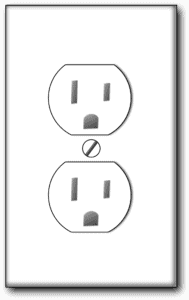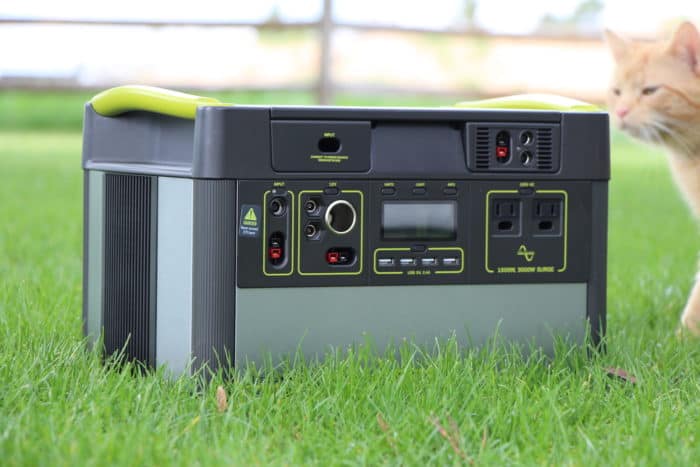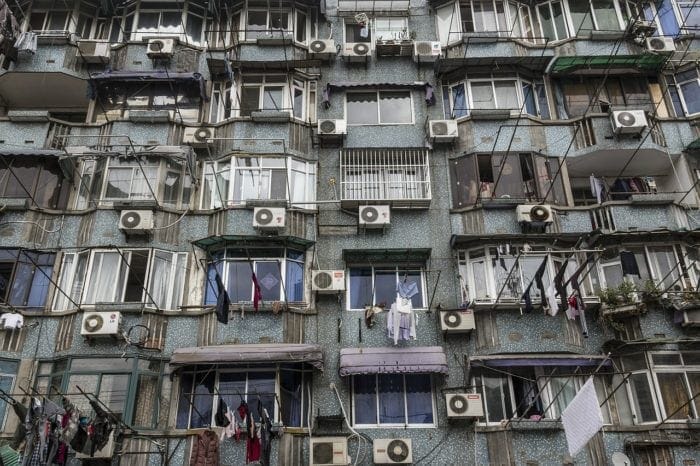Solar Generators and Air Conditioners
Today I am going to focus on powering air conditioners with solar generators. Since I can’t go through every single power station and air conditioner out there, let’s talk a little bit about how you can figure it out by reading about the products.
Related Product: I’ve had success running my 13,500 BTU RV AC with the latest EcoFlow Delta Max (click to view on Amazon). You might also want to consider the portable EcoFlow Wave (click to view on Amazon) which is an air conditioner that can be powered with an optional battery.
What A Solar Generator Can And Can’t Do
Solar generators, also known as power stations are 12V batteries in a box with an inverter and a solar charge controller.
They’ve become increasingly popular as large lithium batteries have become more accessible. Lithium has a lot of pros and is lightweight compared to older types of deep cycle batteries, so they’re great for camping or any kind of traveler.
But what is a solar generator capable of? Can it power everything you need?
If you’re here for the quick answer: It depends on what solar generator and air conditioner you want to pair. Check the inverter rating on the solar generator, then how many watts the air conditioner requires.
For RVers with 13,500/15,000 BTU ACs, the answer is most likely no. You can install an EasyStart on your AC which reduces the power the AC requires to start, but I would suggest buying a smaller portable AC or a window unit instead since it still might not be enough when the solar generator is powering other things in your camper as well.
There are portable units like the BLACK+DECKER BPACT08WT which is rated at 950 watts. With a power station like the Bluetti AC200P, you would be able to run the AC for almost two hours, or longer if you have solar panels recharging it at the same time.
How much power can a solar generator output?
The most limiting factor to how much a solar generator can power or output is the inverter rating. The inverter changes the battery’s DC power to AC and powers the standard AC outlets (just like the wall outlets in your home or RV). An inverter is only capable of outputting a certain amount of watts though, so this is why the inverter rating is relevant when you want to figure out whether it can operate a specific device or not.
Most lithium batteries are capable of discharging at a high rate, and therefore not limiting the power output like the inverter.
One important thing to know about is that these solar generators usually have 15A outlets, not 20A or 30A RV plugs. A 15A outlet at 120V can only handle 1800 watts on its own (15Ax120V).
This can become a limiting factor even if the battery and the inverter in newer power stations are going to be capable of outputting higher watts. I bet 20A and 30A plugs will become more common in future solar generators.

When you look at a solar generator product description there are a lot of numbers to take in. As an example, let’s take a look at the popular power station Goal Zero Yeti 1400.
You’re told a lot of information just by reading the title of the listing.
Yeti 1400 – This is the name of the product
1425Wh – This is the battery capacity in watt hours. Ah (amp hours) and mAh are two other common ways to talk about the battery capacity.
Talking about Wh (watt hours) isn’t the most common one, but used with power stations since it makes it easy to compare the battery capacity in different power stations.
1500 Watt (3000 Watt Surge) AC Inverter – This is the inverter rating, and how much the Yeti 1400 can output in watts at most when using the two AC outlets.
So which of the above is the one we care about when trying to figure out how much the Yeti 1400 can output? The last one, the AC inverter rating.
Related Post: 10 Things You Should Know Before Buying A Goal Zero Yeti
The AC inverter rating usually gives you two numbers, in this case, 1500W and 3000W. The latter is the surge watts, which isn’t as relevant as the first number. Surge/peak watts is how much the Yeti could output for a couple of seconds, but not continuously.
The first number is how much it can output continuously without shutting down.
What are the most popular solar generators inverters rated?
Here are a couple of popular power stations and their respective inverter rating.
The Goal Zero Yeti 1500X – 2000W/3500W surge
The Goal Zero Yeti 3000X – 2000W/3500W surge
The Goal Zero Yeti 6000X – 2000W/3500W surge
The Goal Zero Yeti 1400 – 1500W/3000W surge
The inergy Apex – 1500W/3000W surge
The Ecoflow Delta 1300 – 1800W/3300W surge
The Ecoflow Delta Max 2000 – 2400W/5000W surge
The Ecoflow Delta Pro – 2400W/7200W surge
The Renogy Lycan – 1200W
The Maxoak Bluetti – 1000W
The Maxoak Bluetti AC200P – 2000W/4800W surge
The Jackery Explorer 500 – 500W/1000W surge
The Jackery Explorer 1000 – 1000W/2000W surge

How many watts do air conditioners require to start/run?
So now we know how to figure out how powerful the inverter is on a power station. Now we need to find out how many watts the air conditioner uses.
Here are some rough numbers on how many watts an air conditioner uses based on BTUs.
Each AC is different so the best thing to do is to read the manual, specification, or contact the company directly to figure out starting and running watts. These are just general average guidelines, and higher than what portable ACs or wall units usually require.
15,000 BTU RV AC – 2800-3600 watts to start, 500-1800 to run
13,500 BTU RV AC – 2500-3000 to start, 500-1500 to run
10,000 BTU – 1700-2200 to start, 300-800 to run
7,000 BTU – 1400-2000 to start, 200-700 to run
5,000 BTU – 1000-1500 to start, 100-500 to run

So will any solar generator be able to run your air conditioner? It depends on the air conditioner and how much power it needs.
For example, a portable AC like the No products found. only requires 880 watts. So smaller portable air conditioners or window units would be able to run on the Yeti power station we looked at above.
Conclusion
There are solar generators that will run some AC units. Portable air conditioners like a BLACK+DECKER BPACT08WT can run on a solar generator, but I would suggest a solar generator with at least a 2000W inverter, something like the Bluetti AC200P or larger.
The Bluetti would be able to run the BLACK+DECKER for almost two hours.
Related Post: Yeti 1000 Vs Yeti 1400, How They Compare
RV air conditioners (13,500/15,000 BTU) require a lot of power to start up and can’t be started with any portable power stations on the market right now unless you had an EasyStart installed on the AC unit.
It’s possible that it still wouldn’t run since other things in your camper would be using some energy, but maybe in 2021, we will see a larger solar generator with a 3000W inverter and a 30A plug that can run an RV AC.
Even If Possible, Is It a Good Idea to Run an Air Conditioner off of a Power Station?
If you manage to start an AC on a power station, it won’t run for very long before the battery has drained completely. It could be worth it if you need to cool down a room for 30 minutes, but it’s not something you would be able to run all day.
As an example, if you power a portable AC like the BLACK+DECKER BPACT08WT with a fully charged No products found. which has a 3024Wh battery.
The AC would run for about 2-2.5 hours. Sure, you could connect 700 watts of solar panels to the Yeti and extend the hours to 5-6 on a sunny day, but that would be a big investment to run an AC.
Whether that’s worth it or not is up to you, and I can see myself using one just to cool down a room on a hot summer evening.
What About A Battery-Powered Air Conditioner?
There are some battery-powered air conditioners on the market.
The EcoFlow Wave (click to view on Amazon) doesn’t include a battery, but a 1kWH battery can be purchased and put underneath the Wave to run it on battery.
One cool thing with the Wave is that it has a solar input, so if you have the optional battery you can connect a solar panel to charge it up.
It’s a 4000 BTU AC, so it isn’t very powerful compared to a 13,500 or 15,000 BTU RV air conditioner, but it can cool down a bedroom or an office at least.
If you have any questions, please leave a comment down below.




How do you decide wether to go with a yeti 3000 type powerr station or build a separate component system with batelborn type bateris and separate components.
Well it depends on what you plan on using it for and how much time and money you want to invest. If you have experience with these things it might be a better idea to build your own so you can fix it if it breaks, but it’s obviously not going to be the easiest way to go, and it might not be the cheapest.
There are limitations to power stations, and for full-time RVers that need to be able to run an air conditioner on solar there aren’t too many options right now, yet there are large inverters and lithium battery banks that are capable of doing it.
I have the Black and Decker a/c unit you mentioned, and I am trying to figure out how to power it for up to 8 hours during hot summer nights in the south. I have a very small (10’) trailer with two deep cycle batteries, and I can forego pretty much everything electrical, but I do need a/c. Is there any way to do this? Thanks.
Hello, can someone tell me if I can run the Midea U inverter window AC on an Ecoflow delta pro for at least 8 hours during the night? How do I figure this?
You mentioned the Black & Decker rated 950 watt AC may run longer than 2 hours with solar panels (on a sunny day) charging a BuettiAC200P, simultaneously. Do you have an estimate of how much longer the Black & Decker may run? Which Solar Panel rating would you be referencing? I understand you would be ball parking your estimation.
Which solar generator would work the best for powering a CPAP machine overnight?
Hi,
It depends on the CPAP machine and the settings used, the power usage differs a lot. Something like the EcoFlow River Pro (click to view on Amazon) could be enough with its 720Wh, and it’s a great option since it can recharge quickly.
But I’d want to make sure the power usage of the CPAP won’t drain the battery too fast before spending money on a power station.
It might even be worth buying a watt meter like this one by Kuman (click to view on Amazon). Then you can plug your CPAP into it and check how many watts it uses.
If it reads 50W, it will use a little over 50Wh in one hour, or 500Wh over ten hours. Then a 720Wh power station would be enough.